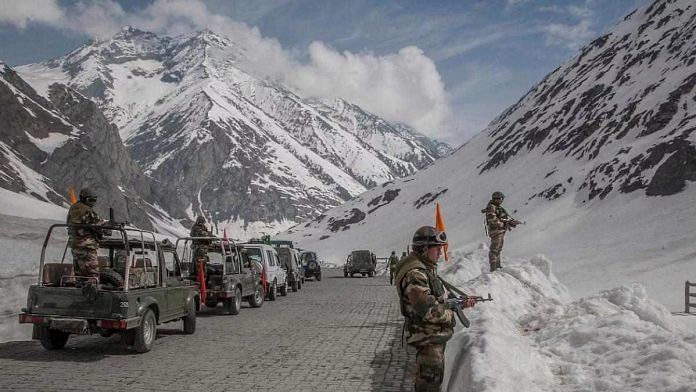Chinese leader Xi Jinping calls for strengthening border defence during a visit to Inner Mongolia. Leaked videos of the Galwan clash target the Indian Army in a new disinformation campaign ahead of the June anniversary. White House confirms the existence of Beijing’s spy base in Cuba since 2019. US Senator says Beijing’s defence budget vastly underreported. Chinascope brings you untold stories from China and the world.
China over the week
Xi once again asked People’s Liberation Army (PLA) to vehemently defend China’s borders and to build the “great wall of steel” during his visit to Inner Mongolia. He made the remarks after listening to a work report on border management and control, and the development of border troops in north China’s Inner Mongolia Autonomous Region.
“Xi Jinping emphasised that to govern the country, one must govern the borders. Frontier defence work is a major event in the governance of the country, which is related to national sovereignty and territorial integrity, to the overall situation of reform, development and stability, to the overall situation of foreign affairs, to the building of a strong country, and the great cause of national rejuvenation,” reported Xinhua News Agency.
Historically, China has often referred to defending borders and seeking ‘national rejuvenation’ when discussing Taiwan. Drawing connections between land frontiers, such as the borders with India, Russia, or Mongolia, is a relatively new phenomenon increasingly linked with China’s rehabilitating national status lost during the era of ‘foreign occupation’.
But what do these repeated assertions about defending the border mean? Since 2015, China has tried incorporating and promoting non-commissioned officers (NCOs) into the PLA. These officers are now part of the brigade system deployed at China’s border areas. The officers need to be constantly trained to function as part of the PLA, which is done through regular propaganda material and study sessions.
Xi’s signature is now deeply entrenched in the defence forces that defend the vast borders from Inner Mongolia to the Line of Actual Control (LAC).
China’s vast geography poses unique challenges, including an expanding desert.
Xi’s trip to Inner Mongolia was more than just about defending border areas. He also emphasised the need to protect the forest and farmland in the region through a forest protection drive called the ‘Three-North Shelterbelt Forest Program’ or the ‘Great Green Wall’. China has faced the acute problem of encroachment in Gobi Desert, which destroyed the productive topsoil of farmlands over the years, expanding the surface area of the desert. Beijing has designed a project to build a series of windbreaking forest strips to halt forest encroachment.
Though the ‘Great Green Wall’ project has been around since 2009, its effectiveness in stopping desert growth has yielded mixed results.
As the 15 June anniversary of the Galwan Valley clash approaches, sock puppet handles on Twitter – likely linked to Beijing or Islamabad – have reinitiated the information warfare targeting India-China border hostilities.
In a long thread on Twitter, graphic images and videos of PLA and Indian soldiers following the clash were shared on 10 June. Some of them show mutilated bodies of Indian soldiers.
One leaked photo identifies an Indian Army soldier with their regiment’s name and service number.
Earlier, the videos of the clash recorded by PLA soldiers were first leaked on the Chinese social media platform Weibo and they later surfaced on Twitter. But this time, the sock puppet account shared the videos directly to Twitter to show the Indian Army in a position of weakness.
China’s external propaganda targeting the Indian Army aligns with PLA’s objective of winning through information warfare without direct combat. Though unsurprising, the leaks show that the gap to reaching the pre-Galwan status quo remains wide as ever.
China in world news
In recent years, doubts have emerged about China’s military budget spending as many believe the officially reported number is drastically underestimated.
According to US Senator Dan Sullivan, China spends about $700 billion on defence.
“Mr. Sullivan has said on the Senate floor that US intelligence officials told him at a recent briefing the right figure is closer to $700 billion,” reported Wall Street Journal.
Sullivan made these remarks on the Senate floor on 1 June, which have since started a debate about proposed military budget cuts. Beijing does spend far more on its military than what is officially declared but we don’t know how accurate the $700 billion figure is.
If true, the gap between China and the US military budget ($840 billion), wouldn’t be as monumental as Beijing would like us to believe.
The raging debate on China’s military budget comes amid rumours about a Chinese spy base in Cuba.
On 8 June, the Wall Street Journal reported that Cuba agreed with Beijing to host a secretive listening post to capture the signal communications from the nearby US mainland.
The Pentagon initially refuted the report, calling the story inaccurate.
On Sunday, the White House confirmed that China had used a base in Cuba for signals collection since 2019, and the WSJ report calling the base ‘new’ was incorrect.
Also Read: China sends two drones in one week around Taiwan but calls US the ‘empire of hacking’
Must read this week
Decoding Chinese Politics — Asia Society
Kong Yiji: The memes that lay bare China’s youth disillusionment — Grace Tsoi
The Road to Modi’s Ambitious Make-in-India Goal Runs Through China — Vrishti Beniwal and Ruchi Bhatia
Are China and India bound for another deadly border clash? — John Pollock and Damien Symon
The author is a columnist and a freelance journalist. He was previously a China media journalist at the BBC World Service. He is currently a MOFA Taiwan Fellow based in Taipei and tweets @aadilbrar. Views are personal.
(Edited by Ratan Priya)



